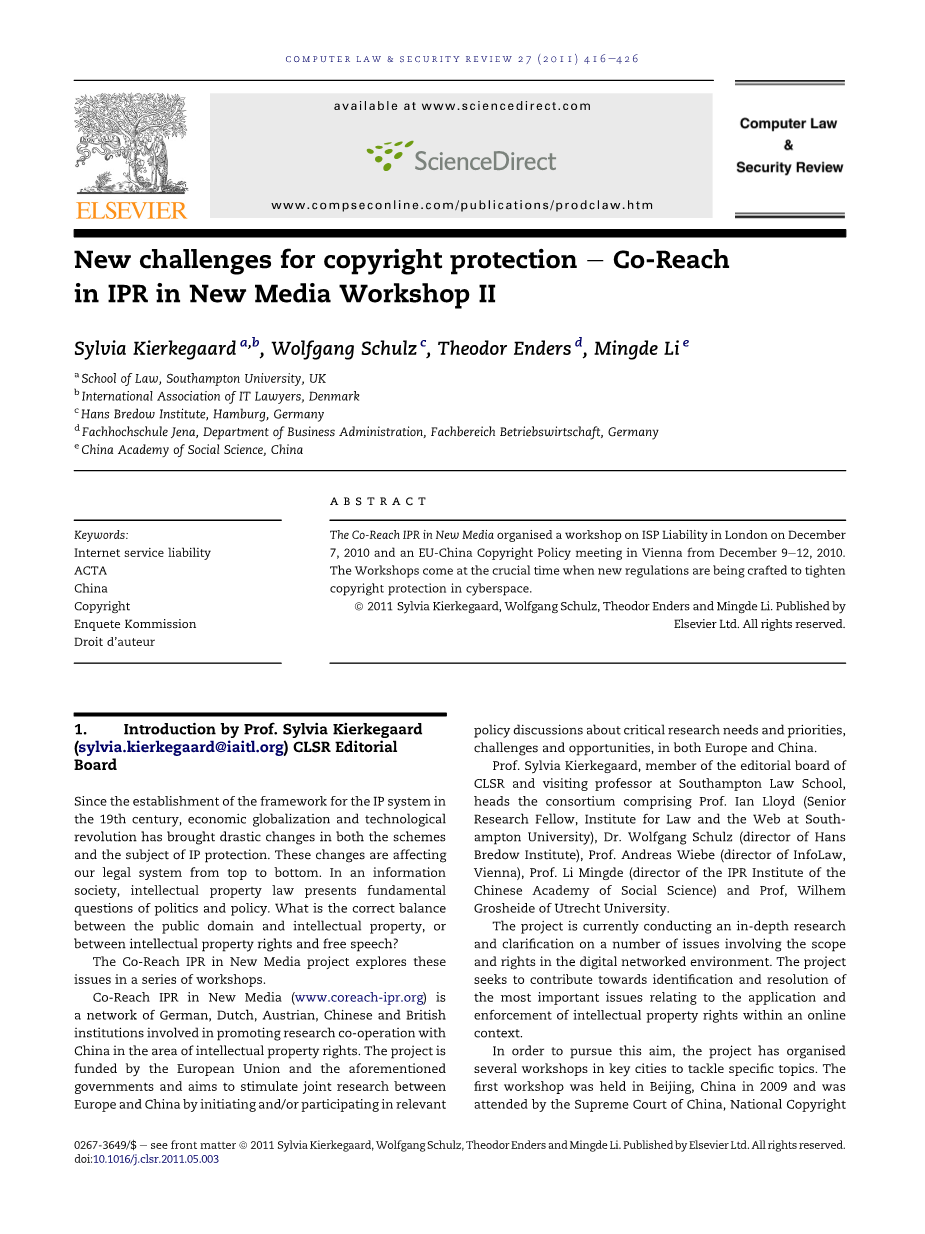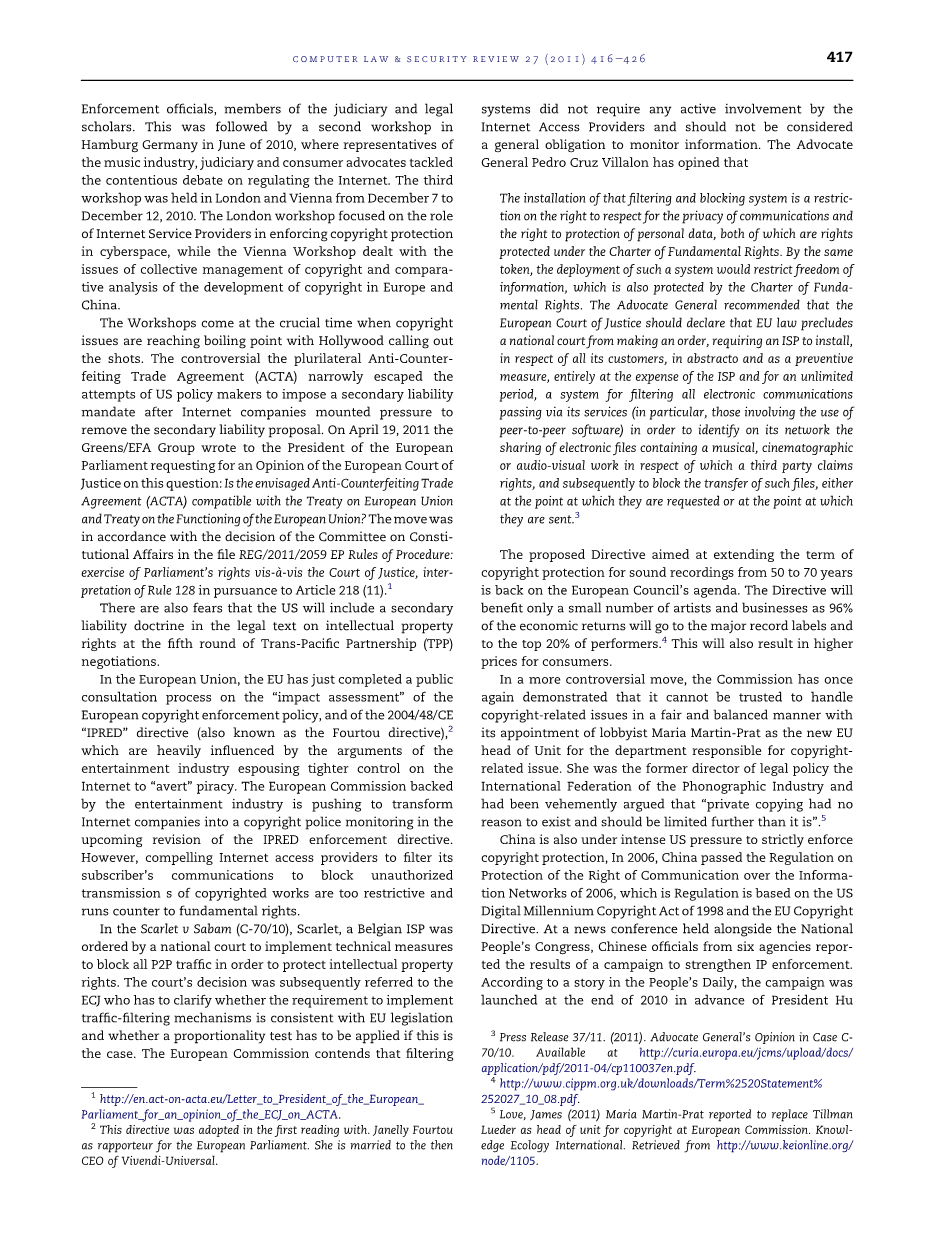

英语原文共 11 页,剩余内容已隐藏,支付完成后下载完整资料
2020年2月
目 录
英文原文及中文译文
Abstract 2
Country report for Germany Introduction 2
The framework 2
Current issues in the course of the discussion 3
Limits to copyright 3
Enforcement 5
Conclusion 6
Chinese copyright law 6
Judicial development 7
New views 9
Final remarks 10
摘要 12
德国情况介绍 12
体系框架 12
存在讨论的问题 13
版权限制 13
执法 14
总结 14
中国版权法 15
司法发展 15
新观点 17
结束语 17
英文原文
New challenges for copyright protection e Co-Reach
in IPR in New Media Workshop II(节选)
Abstract
The Co-Reach IPR in New Media organised a workshop on ISP Liability in London on December 7, 2010 and an EU-China Copyright Policy meeting in Vienna from December 9e12, 2010. The Workshops come at the crucial time when new regulations are being crafted to tighten copyright protection in cyberspace.
Country report for Germany Introduction
Germany has seen a succession of copyright amendments during the last couple of years. Many of those have been technologically driven.12 The internet and related issues played a major role. During the last month a meaningful debate arose on the mid-range future of copyright policy in Germany. One trigger is defifinitely the academic debate on copyright issues. The report by van Eechoud and others13 has been inflfluential as well as publications on the whole concept of copyright.14Furthermore, certain parties interested in a more flflexible and Internet-adequate copyright regulations have been lobbying for changes to the law.
One reaction to the problem of coping with Internet related issues e is the setting up of the so-called Enquete Kommission “Internet und digitale Gesellschaft”, a committee of enquiry set up by the German parliament (Bundestag) to study the relationship between our digital society and the Internet.
The framework
In the copyright project group of the commission there have been intensive debates about the roots of the concept of copyright which are found in the continental-European system of droit drsquo;auteur and which are closely related to theconcept of intellectual property. It is this very analogy to (physical) property that e according to a growing body of opinion in Germany e is no longer adequate in the digital age. However, the Enquete Kommission has seen at an early stage that the debate about terms and concepts is no substitute for a proper analysis of the problems in specifific fifields of copyright, where of course the basic assumptions of what copyright should aim at play a major role.
According to the Federal constitutional court, the German Constitution protects copyright under both the right to property clause and the personality right clause. However, the court has ruled that public interests can lead to legitimate limits to copyright protection under the German constitution (cf. BVerfGE 31, 229). Therefore, to some extent, the German constitutional framework is open for more utilitaristic approach.
Current issues in the course of the discussion
In order to convey a more in-depth insight into the work of the Enquete Commission, the state of debate on selected issues presented below.
What is of critical importance in this case are technological developments of bi-directional infrastructures, that is to say networks, which do not only facilitate receipt but also the modulation of, and the ability to describe, content. In the wake of digitisation, a process of democratisation of work creation and presentation has been discernible, causing professional mediators of copyright-protected works in particular (press and book publishers, producers of sound storage media and fifilms) to face structural changes.
Limits to copyright
In order to ensure an adjustment to the prevailing circumstances in legal terms, for one thing an extension of new, specifific intellectual property rights (ancillary or neighbouring copyrights), such as a right of this kind for press publishers, and the fundamental revision of a remuneration system for the use of works on the Internet, is under consideration16, for another, however, the study includes developments on the Internet which make it appear necessary to readjust the borderline relating to the permissibility of a non-commercial use of works protected by intellectual property rights.
The fact that users take part in public communication by producing contributions of their own, uploading these and exchanging them on platforms, illustrates the changed user patterns in the digital information age. Accordingly, forms of work exploitation are evident that generally entail the assertion of intellectual property rights but extremely rarely compete commercially with the professional mediation of works in the actual sense, for instance because they serve exclusively for social communication purposes (e.g. the integration of protected content into own videos, creating a persiflflage of original videos by blending in new sound tracks or by changing image sequences, also in the form of “fan videos”). Even tho
剩余内容已隐藏,支付完成后下载完整资料
资料编号:[254346],资料为PDF文档或Word文档,PDF文档可免费转换为Word


